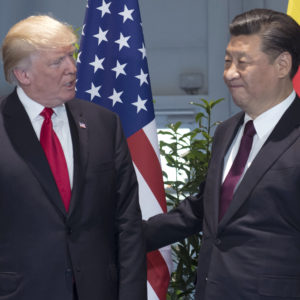SEOUL — U.S. President Donald Trump faces a diplomatic challenge that would be daunting enough for any national leader, let alone one noted for blunt, non-diplomatic language, when he arrives in Beijing on Wednesday after summits here and in Tokyo.
Hopscotching among capitals of East Asian countries with long histories of hostility, Trump will be able to tell China’s President Xi Jinping all he’s taking away from meetings with Japan’s Prime Minister Shinzo Abe and South Korea’s President Moon Jae-in.
No doubt the Chinese and American presidents will manage a show of cheer and good-will, just as they did at their informal meetings earlier this year at Trump’s Mar-a-Lago estate. For Trump the challenge will be to persuade Xi of the need to get even tougher on North Korea, which depends on China for most of its oil and much of its food.
Trump may find Xi quite amenable now that the Party congress is over and new leaders in place. To all outward appearances more powerful than ever, the Chinese president surely will put on a show of strict adherence to UN sanctions against the North even while demurring on pleas to cut off the oil.
The dialogue may get strained, however, when Trump reports on what he’s heard from Abe in Tokyo. Riding high after the success of his ruling Liberal Democratic Party, allied with the much smaller Buddhist-backed Komeito, Abe wants to build up Japan ‘s euphemistically named “self-defense” forces to counter any North Korean threat. To do so, he has to persuade two thirds of the Japanese diet, and then half the country’s voters, to “say no” to Article Nine of the so-called “peace constitution,” ghost-written by Americans during the U.S. “occupation” after the Japanese defeat in August 1945.
Chinese react instinctively against notions of Japan’s renaissance as a military power. There are too many awful memories of Japanese conquest of much of the country, notably the northeast. Those memories go deep into history. No one forgets the Sino-Japanese war that ended with Japan’s victory in 1895 and the Japanese takeover of Formosa or Taiwan, island home of the “nationalist” Chinese forces that fled there before the final Communist victory on the mainland on October 1, 1949.
Sandwiched between Trump’s stops in Tokyo and Beijing, South Korea presents its own issues. Trump will no doubt affirm the “ironclad” nature of the U.S.-South Korean alliance but will not convince President Moon of the need for a “military option” if diplomacy with North Korea fails.
Xi, looking for clues to how Trump and Moon got along, will pick up on signs of disagreement. In the quest for “stability” on the Korean peninsula, he will not accept arguments of the need to “preemptively” annihilate North Korean nuclear and missile sites.
In navigating his way through the region, Trump will mingle calls for peace with declarations of power including the ability to “destroy” North Korea if the North Korean leader, Kim Jong-un, shows signs of making good on his more bizarre threats.
To Xi, however, such rhetoric also threatens Chinese interests elsewhere. He is not going to agree with American claims of the right of U.S. warships to go anywhere they wish in the South China Sea. Nor will he compromise on Japanese claims to those islands in the East China Sea known to the Japanese as the Senkakus and to the Chinese as Diaoyu.
Listening to Trump’s assurances of good-will, however, might Xi relent on his strenuous objections to South Korea accepting a U.S. battery known as THAAD for Terminal High-Altitude Area Defense? Might Trump persuade Xi that China has punished South Korea enough for the sin of hosting THAAD, which the Americans and South Koreans insist is to shoot down high-flying North Korean missiles, not to menace China?
If Trump can talk. Xi into passive acquiescence on THAAD, then his mission to Beijing will have been a success.

